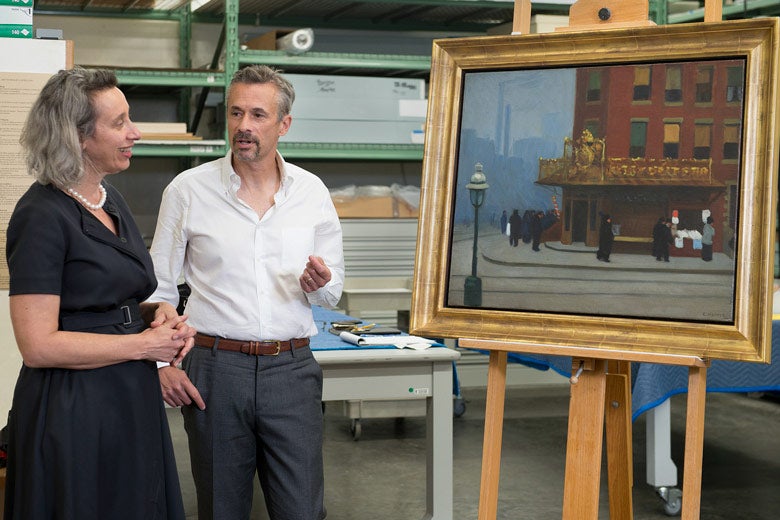 |
June 9, 2015
Stanford's Cantor Arts Center acquires an early Edward Hopper painting
"New York Corner," 1913, finds a new home at Stanford University. By Robin Wander

Connie Wolf, director of the Cantor, and Alexander Nemerov, professor of art history, view New York Corner (Corner Saloon), 1913, by Edward Hopper. (Photo: Linda A. Cicero / Stanford News Service)
The Cantor Arts Center has announced the major new acquisition of a painting by Edward Hopper, New York Corner (Corner Saloon), 1913. One of Hopper's early paintings, the oil on canvas was created when Hopper was just 31 and still struggling to establish himself, but it heralds the artist's influential career and prominence as one of America's great realist painters. When it was first exhibited in New York shortly after it was completed, the critics praised it as a "perfect visualization of a New York atmosphere" and for its "completeness of expression."
Alexander Nemerov, the Carl and Marilynn Thoma Provostial Professor in the Arts and Humanities at Stanford University and the incoming chair of the Department of Art & Art History, said of the painting, "This great picture that we now have in our collection gets singled out as a key – perhaps even a first – painting he made in his representative style, the style that would make him famous and so influential. It is remarkable that here on campus we now have this painting that started it all."
Edward Hopper is one of the greatest American artists of the 20th century. He was born in Nyack, New York, in 1882 and died in Manhattan in 1967. His powerful and iconic images of cityscapes, landscapes, seascapes and solitary figures speak to the rugged individualism of American culture in both its beauty and isolation. His impact on the imagination of generations of artists, filmmakers and writers remains strong.
American artist Richard Diebenkorn studied Hopper's work when he was a student at Stanford and his reflection on that time in his life is captured by Jane Livingston in her essay for the catalog The Art of Richard Diebenkorn. "I embraced Hopper completely … It was his use of light and shade and the atmosphere … kind of drenched, saturated with mood, and its kind of austerity … It was the kind of work that just seemed made for me. I looked at it and it was mine," Diebenkorn said.
Connie Wolf, the John and Jill Freidenrich Director of the Cantor Arts Center, called New York Corner a transformational acquisition that reflects the museum's new approach to add to the collection strategically. "It is an extraordinary painting and allows us to deepen and strengthen our commitment to being a unique resource for teaching and learning for students, faculty, artists and the broader community. With over 44,000 objects in our collection, we are focusing on acquiring key works through gifts and purchase that will transform our connection to the academic life of the university. Our five-year digitization and inventory project allows us to better understand the opportunities to build and strengthen the collection and make strategic additions across the primary areas of collecting," she said. "This acquisition builds on the recent significant gifts of works by Andy Warhol, Richard Diebenkorn and Jacob Lawrence and also helps us create a stronger foundation to the works now at the Anderson Collection at Stanford University."
In keeping with this focus on strengthening the collection are other key acquisitions, including works by Honoré Daumier, Robert Frank, Lee Friedlander, William Keith, Richard Misrach, Elizabeth Murray, Georgia O'Keeffe and Carrie Mae Weems.
The expanding Cantor collection is the core of the museum's mission to teach, to engage in new scholarship and to connect with a diversity of audiences on campus and beyond. Together with the Anderson Collection of American art next door, Stanford continues to strengthen its connection between the study, creation and experience of art.
Nemerov will teach a large art history lecture course in the fall where students are required to write about a work of art at the Cantor; he predicted New York Corner will be a compelling work for his students. "The painting will start to become part of the consciousness of Stanford undergraduates then and there," he said. "To me, the new Hopper painting makes me think of America in 1913, of all one might say about that time, of how that time becomes newly present, newly vivid, here at Stanford thanks to this picture being on campus."
New York Corner will go on view in late July in an exhibition featuring other work in the museum's permanent collection that explores how this significant acquisition can be a source of study and inquiry by examining the artists who influenced Hopper, how Hopper has and continues to influence other artists, looking at America in 1913 when the work was made, and positioning Hopper among his peers.
Edward Hopper (U.S.A., 1882–1967), "New York Corner (Corner Saloon,)" 1913. Oil on canvas. Museum purchase made possible by the Halperin Art Acquisition Fund, an anonymous estate, Roberta & Steve Denning, Susan & John Diekman, Jill & John Freidenrich, Deedee & Burton McMurtry, Cantor Membership Acquisitions Fund, an anonymous acquisitions fund, Pauline Brown Acquisitions Fund, C. Diane Christensen, an anonymous donor, Modern & Contemporary Art Acquisitions Fund, and Kazak Acquisitions Fund.
-30-
|
 |